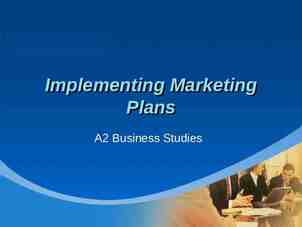Marketing Mix Martin Krištof spring 2005
26 Slides164.00 KB
Marketing Mix Martin Krištof spring 2005
Introductio n DEFINITION: Promotion is communication with actual and potential buyers OBJECTIVE: To convince target market of the product’s differential advantage NECESSARY PREREQUISITE: Ought be guided by a promotional strategy: a plan for the optimal use of the promotional mix
Elements of the Promotional Mix Advertising Ingredients Ingredients of of the the Promotion Promotion Mix Mix Publicity Personal Selling Sales Promotion
The Effects (outcomes) of Advertising Advertising influences: – market share – the consumers’ behaviour – brand loyalty – perceptions of attributes
Promotion and the Demand Curve Price Price D2 D1 D D 0 0 Quantity Quantity A. To be more inelastic Promotion efforts may be targeted to make demand for the firm’s products more inelastic and so more resistant to countermoves by the competition. B. to the right Promotion efforts may be targeted to increase the demand for the firm’s products.
Promotion and the Demand Curve Price D D 0 Quantity Promotion efforts may be targeted to both increase demand for the firm’s products and to make demand more inelastic C. Both to the right and more inelastic Price 0 Price Price D2 D1 Quantity A. To be more elastic 0 D D Quantity B. to the right D 0 D Quantity C. Both to the right and more elastic
Major Types of Advertising Corporate Image Institutional Advertising Advocacy Advertising Types Types of of Advertising Advertising Pioneering Product Advertising Competitive Comparative
Major Types of Advertising (cont) Institutional advertising – to establish, change or maintain the firm’s identity - not an attempt to sell anything Product advertising – pioneering advertising » stimulate demand for a new product: primary demand – competitive advertising » attempts to increase sales: brand insistence – comparative advertising » directly or indirectly compares two brands
Setting Advertising Objectives Introduce New Products Position Brands Obtain Outlets Ongoing Contact Strategy Decisions in Setting Advertising Objectives Support Sales Force Get Immediate Action Maintain Relationships
Choosing Media Television Yellow Pages Newspapers Magazine Major Kinds of Media Direct Mail Outdoor Radio Internet
Advertising on the Internet ? ? ? ? ? Many Forms Seek Direct Response More Exposure Better Targeting Context Ads/Pointcasting Pay for Results
Public Relations and Publicity Public relations: shape the public’s perceptions of and attitudes towards the firm Communicates with stakeholders in manners other than advertising Publicity: non-paid for media exposure for the firm: both positive and negative
Personal Selling Two people in a purchasing situation trying to influence each other Each part has its own objectives – buyer wants to minimise costs or buy the best quality – seller wants to maximise price, sales and profits Often a well-prepared presentation Modern approach is relationship selling
Steps in the Personal Selling Process Prospect for new customer Set effort priorities Evaluate needs of established customers Preplan sales call and presentation(s) Make sales presentation Close sale Follow up to establish Follow up to maintain Feedback Select target customer
Sales Promotion All marketing activities other than advertising, personal selling and public relations, that stimulates sales and dealer effectiveness Short-term, immediate stimulation of demand Can be aimed at consumers, intermediaries or employees Examples: free samples, coupons etc.
Sales Promotion Activities Aimed at final consumers or users Contests Coupons Aisle displays Samples Trade shows Point-of-purchase materials Banners and streamers Trading stamps Sponsored events Aimed at middlemen Price deals Promotion allowances Sales contests Calendars Gifts Trade Shows Meetings Catalogs Merchandising aids Aimed at company’s own sales force Contests Bonuses Meetings Portfolios Displays Sales aids Training materials
The Communication Process Noise Sender Encoding Channel Channel Decoding Receiver
Integrated Marketing Communications Ideally communication from each promotional element ought to be integrated The message reaching the consumer must be consistent irrespective of the medium used Organisational arrangements must ensure IMC The responsibility of the marketing communications manager
Goals and Tasks of Promotion Informing Reminding Target Audience Persuading
AIDA and the Hierarchy of Effects Purchase Conviction Preference Liking Knowledge Awareness Attention Cognitive Interest Affective Desire Action Conative
When Elements of Promotion Are Most Useful Effectiveness Advertising Personal selling Sales promotion Public relations Awareness Knowledge Liking Preference Very effective Somewhat effective Not effective Conviction Purchase
Factors that Affect the Promotion Mix Nature of the Product Stage in the Product Life Cycle Target Market Characteristics Type of Buying Decision Available Funds Push–and–Pull Strategies
Creating a Promotion Plan Analyse the Marketplace Identify Target Market Set Promotion Objectives Develop Promotion Budget Choose Promotion Mix
Criteria for Setting Promotion Objectives Promotion objectives should: be measurable, concrete be based on sound research, with a well-defined target audience be realistic reinforce the overall marketing plan and relate to specific marketing objectives
Examples of Promotion Objectives Informative (Awareness) Objective To increase the top-of-mind awareness level for Black Cat peanut butter from 16 percent to 24 percent Persuasion (Attitudinal) Objective To increase the percentage of parents who feel that Black Cat peanut butter is the best peanut butter for their children from 22 percent to 35 percent Reminder Objective To remind consumers that Black Cat peanut butter is the creamiest peanut butter and is available at their nearest grocery and convenience stores
Techniques for Setting Promotion Budgets Arbitrary Allocation All - You - Can - Afford Competitive Parity Percent of Sales Market Share Objective and Task































